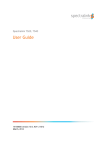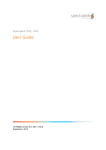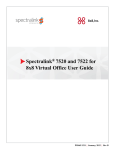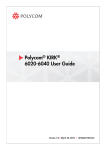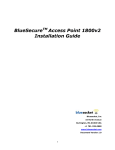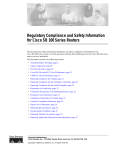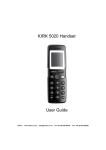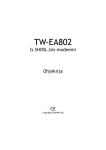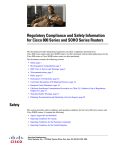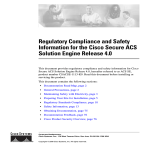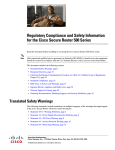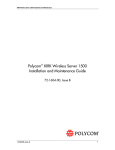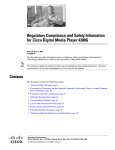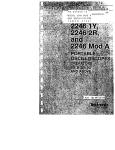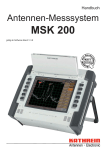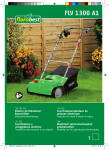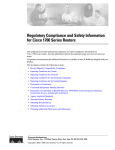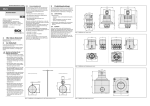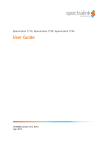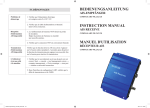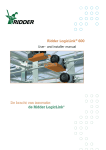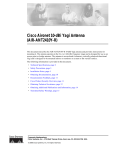Download User Manual - Newegg.com
Transcript
BlueSecure™ Access Point 1800 Installation Guide Bluesocket, Inc. 10 North Avenue Burlington, MA 01803 USA +1 781-328-0888 www.bluesocket.com Part Number: 870-01500-M00 Document Version: 2.0 Copyright Notice Copyright © 2008 Bluesocket, Inc. All rights reserved. No part of this document may be reproduced in any form or by any means, electronic or manual, including photocopying without the written permission of Bluesocket, Inc. The products described in this document may be protected by one or more U.S. patents, foreign patents, or pending patents. This document is provided “as is” without warranty of any kind, either express or implied, including, but not limited to, the implied warranties of merchantability, fitness for a particular purpose, or non-infringement. This publication could include technical inaccuracies or typographical errors. Changes are periodically added to the information herein; these changes will be incorporated in new editions of the document. Bluesocket inc. may make improvements or changes in the products or the programs described in this document at any time. Trademarks Bluesocket, The Bluesocket Logo, Secure Mobility, BlueView, BlueSecure, HighDataDensity, DynamicRF, and CellularLAN are trademarks or registered trademarks of Bluesocket, Inc. All other trademarks, trade names and company names referenced herein are used for identification purposes only and are the property of their respective owners. Publication Date: December 16, 2008 ii Contents Overview .................................................................................................1 Familiarizing Yourself with the BSAP Hardware ............................................2 Fixed Antennas......................................................................................3 LED Indicators .......................................................................................3 Ethernet/PoE Connector .........................................................................4 Reset Button ..........................................................................................4 Kensington Security Slot..........................................................................4 Provisioning Your Bluesocket WLAN for BSAPs .............................................4 Deploying BSAPs on the Same Layer-2 Subnet as the BSC ..........................5 Deploying BSAPs with Layer-3 Connectivity to the BSC ...............................6 Selecting a BSAP Installation Location ..........................................................7 Mounting the BSAP....................................................................................7 Dropped Ceiling Tool requirements ..........................................................8 Conventional Ceiling Tool requirements....................................................8 Mounting Kit Contents ............................................................................8 Dropped Ceiling Kit Installation ...............................................................9 Ceiling Kit Installation...........................................................................13 Mounting on a Wall.............................................................................17 Connecting and Powering the BSAP ..........................................................19 Using the BSAP Command Line Interface (CLI).............................................20 Accessing the BSAP CLI ........................................................................20 Navigating the BSAP CLI ......................................................................20 BSAP Default Configuration...................................................................21 Setting the BSAP and Home BSC IP Addresses Using the CLI .....................22 Using the BSAP’s Site Survey Mode .......................................................23 General Specifications .............................................................................24 Declarations of Conformity and Regulatory Information ................................27 Safety Warnings for BlueSecure™ Access Point 1800 .................................31 BlueSecure™ Access Point 1700 Installation Guide iii Contents iv Overview The BlueSecure Access Point 1800 is a next-generation, “thin” access point that works in conjunction with BlueSecure Controllers (BSCs) for enterprise wireless LAN (WLAN) deployments. The BlueSecure Access Point 1800 features dual radios supporting 802.11a/n and 802.11b/g/n with an embedded MIMO antenna panel under the top cover of the AP. BSAPs are simple to configure and require only minimal provisioning to make them fully operational on a WLAN secured and managed by a BlueSecure Controller BSAPs can be directly attached to any existing Layer-2 or Layer-3 Ethernet switch and communicate with the BSC across any subnet boundary. Once the BSAP has discovered and established Layer-2 or Layer-3 communication with its home (i.e., host) BlueSecure Controller, advanced configuration and provisioning may be applied either to individual BSAPs or globally across the entire WLAN using the BSC’s web-based Administrator Console. Figure 1: BSAPs Automatically Discover BSCs Across L2/L3 Networks Once a BlueSecure Access Point has downloaded its configuration from its home BlueSecure Controller, the BSAP initializes its radios and begins servicing clients. This guide provides complete installation procedures for your BSAP including: • familiarizing yourself with the BSAP hardware • provisioning your Bluesocket WLAN for BSAPs • selecting a BSAP installation location • connecting and powering the BSAP • using the BSAP command line interface (CLI) BlueSecure™ Access Point 1800 Installation Guide 1 Familiarizing Yourself with the BSAP Hardware Figure 2 illustrates the BSAP hardware. Familiarize yourself with the labeled components before attempting to install the BSAP. Figure 2: BSAP Hardware Components 2 Familiarizing Yourself with the BSAP Hardware Fixed Antennas The BSAP-1800 utilizes an embedded MIMO antenna panel under the top cover of the AP for wireless communications. There are three elements for each band and all elements are used for both transmit and receive operations. The BSAP1800 also leverages the embedded Atheros radios and antenna panel to support high-throughput communications with mobile devices. LED Indicators The following grouping of LED indicators is located on the top of the BSAP-1800 housing:. The two status LEDs together indicate the following software operational modes, depending on whether each LED is off, on, or blinking: Table 1: BSAP Status LEDs Left Status LED Right Status LED Indicates Off Off Failure On Off Waiting for IP Address Blinking Off BSC discovery in progress On On System is operational Blinking Blinking Software download in progress Link1 refers to the 802.11b/g/n Link and Link 2 refers to the 802.11a/n Link. When the LED is on, it indicates that the unit is on and the radio active (note that when unit is booting, the LED defaults to on even though the radio is disabled). Activity 1refers to 802.11b/g/n Activity and Activity 2 refers to 802.11a/n Activity. When the LED is on, it indicates data activity on the Ethernet link. The BSAP does not have a power switch. It is powered on when connected to an optional external AC power adapter (BSAP-PWR-000-00-0), and the power adapter is connected to a power source. The BSAP power adapter automatically adjusts to any voltage between 100-240 volts at 50 or 60 Hz. No voltage range settings are required. The BSAP may also receive Power over Ethernet (PoE) from a model BSC-600/ 1200 Controller, switch or other network device that supplies power over the network cable based on the IEEE 802.3af standard. BlueSecure™ Access Point 1800 Installation Guide 3 Ethernet/PoE Connector The BSAP-1800 has one auto-sensing 10BASE-T/100BASE-TX/1000BaseT RJ-45 connector that can be attached directly to 10BASE-T/100BASE-TX/1000BaseT switches to provide a full-duplex link. These segments must conform to the IEEE 802.3 or 802.3u specifications. This connector uses an MDI (i.e., internal straight-through) pin configuration. You can use straight-through twisted-pair cable to connect this port to most network interconnection devices such as a switch or router that provide MDI-X ports.This connector will sense and correct wiring polarity, so no crossover cable is required. This connector uses an MDI (i.e., internal straight-through) pin configuration. You can use straight-through twisted-pair cable to connect this port to most network interconnection devices such as a switch or router that provide MDI-X ports. The BSAP appears as an Ethernet node and performs a bridging function by moving packets from the wired LAN to remote workstations on the wireless infrastructure. The Ethernet/PoE RJ-45 connector also supports Power over Ethernet (PoE) based on the IEEE 802.3af standard. 802.3af specifies Power over Ethernet for “mid-span”, where a PoE injector are located in the path between the network and the AP, as well as “PSE”, where the power is supplied by the network switch the AP is attached to. Mid-span devices typically provide power on the unused pairs (4+5 & 7+8) and only provide 100Mbps maximum throughput. To realize the full benefit of 802.11n, the BSAP1800 should be connected to a Gigabit Ethernet PoE switch or injector, such as Bluesocket model BSAP-POE-001-00-0. Reset Button Use this button to reset the BSAP or restore its factory default configuration. If you hold down the button for less than 5 seconds, the BSAP will perform a hardware reset. If you hold down the button for 5 seconds or more, any configuration changes you may have made are removed, and the factory default configuration is restored to the BSAP. Kensington Security Slot The BSAP includes a Kensington security slot on the side panel. You can prevent unauthorized removal of the BSAP by wrapping a Kensington security cable (not provided) around an unmovable object, inserting the lock into the slot, and turning the key. Provisioning Your Bluesocket WLAN for BSAPs There are prerequisites that must be met before deploying BSAPs in a live network environment. These prerequisites ensure that the BSAPs are able to discover and connect to a host BlueSecure Controller. Implementing these prerequisites also relieves you from the need to manually configure each deployed BSAP. 4 Provisioning Your Bluesocket WLAN for BSAPs The deployment prerequisites for BSAPs are: • • BSAP IP Address - Each BSAP requires a unique IP address. Host BlueSecure Controller IP Address - Each BSAP also needs the IP address of the host BSC to which it will connect and from which it will obtain its software image and configuration. This section describes how to provision your Bluesocket WLAN when deploying BSAPs: • • On the same Layer-2 subnet as the BSC Across a routed network with Layer-3 connectivity to the BSC Deploying BSAPs on the Same Layer-2 Subnet as the BSC If the BSAPs are on the same subnet as the home BlueSecure Controller as shown in Figure 3, you can run a DHCP server on the BSC to manage IP address assignment to BSAPs. In this scenario, the BlueSecure Controller must be the only DHCP server for the subnet. Alternatively, you can configure the BlueSecure Controller to run a DHCP relay agent to relay DHCP communications between the BSAPs and a DHCP server on your network. Run a DHCP Server or a DHCP Server Relay Agent on the BSC BSAPs will Automatically Discover and Communicate with their Home BSC Figure 3: Deploying BSAPs on the Same Layer-2 Subnet as the BSC When you run a DHCP server or a DHCP relay agent on the BSC to assign IP addresses to BSAPs on the managed side, the BSC will also pass its IP address to the BSAPs automatically using vendor-specific option 43. The BSAP will then connect to the IP provided by the DHCP vendor option as its host BSC. See the BlueSecure Controller Setup and Administration Guide for detailed DHCP server and DHCP relay agent configuration procedures. In this deployment scenario, simply connect and power on the BSAPs. They will automatically discover and communicate with their home BSC. BlueSecure™ Access Point 1800 Installation Guide 5 Deploying BSAPs with Layer-3 Connectivity to the BSC You can also deploy BSAPs on a routed network with Layer-3 connectivity to the BSC as shown in Figure 4. BSAPs Receive their IP Addresses from Network DHCP Server BSAPs Receive Home BSC IP Address Using DHCP Option 43 or DNS Network DHCP Server Network DNS Server Figure 4: Deploying BSAPs Across a Routed Network In this deployment scenario, you must ensure that each BSAP is able to communicate with the BSC across the routed network by verifying that: • There are no NAT devices between the BSAPs and the BSC • Protocol 97, UDP Port 53, and TCP/UDP Port 33333 traffic is allowed between the BSAPs and the BSC Each BSAP will receive its IP address from your existing network DHCP server. An exception case is if the BSAP is beyond a managed side router, running IP helper. Then the BSAP will receive its IP address from the BSC, and be able to discover it without any additional configuration. The BSAP also needs the IP address of the home BSC to which it will connect and from which it will obtain its software image and configuration. Again, this is not needed if the BSAP is on the managed side getting a relayed IP address from the BSC. You can provide the home BSC IP address to a BSAP using one of the following methods: • DHCP Server Option 43 - You can manually configure the DHCP server on your network to send BSC IP addresses to BSAPs using DHCP vendorspecific option 43. In DHCP requests sent from the BSAP, the BSAP uses option 60 Vendor class identifier with a value of BlueSecure.AP1500 to identify itself to the DHCP server (Note that all BSAPs —1500,1540,1800 —identify as AP1500 for option 43). Refer to the documentation supplied with your DHCP server when configuring vendor-specific option 43 • 6 DNS Server Configuration - BSAPs are factory configured with apdiscovery as the DNS hostname. You can configure a DNS server on your network with an entry for apdiscovery with the home BSC Controller IP address as the resolution. Selecting a BSAP Installation Location To configure this, add a NAME record to the DNS server for apdiscovery (at the domain server that the BAP will receive). Point this name to one or more BSC IP addresses (managed, protected or VLAN depending on the network configuration). So for example, if there are two BSCs (192.168.100.23 and 192.168.100.28), and the domain is customer.com, add two NAME records to customer.com, for the name apdiscovery.customer.com. One should resolve to 192.168.100.23 and one to 192.168.100.28. PTR (i.e., pointer) records are not needed for this portion of discovery. Selecting a BSAP Installation Location BlueSecure Access Points should be positioned for maximum throughput and range between other BSAPs and wireless client devices. Normally, you should locate the BSAP on the ceiling away from obstructions. Range and performance are dictated by the distance between the BSAP and client radios, and by obstacles that may be present in a specific building or office environment. The following positioning guidelines are suggested: • Document all the BSAPs and client devices you wish to include in your wireless network. Record the MAC address, serial number, and placement of each BSAP. • Wired LAN and power connections must be available for each BSAP at the desired installation location. If a power outlet is not available near the access point, mid-span power inserters are recommended. • If building blueprints or floor plans are available, use them to define potential client device locations and likely roaming areas. • Identify possible obstacles or sources of interference that could affect signal strength (for example, walls, metal objects). • Install the BSAP in an area where large steel structures such as beams, pillars, shelving units, bookcases, and filing cabinets do not obstruct radio signals to and from the BSAP. • Once BSAPs have been installed and configured, use site survey and monitoring utilities supplied with the client adapters to test signal strength at various locations. Modify the positioning of the BSAPs and client stations as required for optimum performance. Mounting the BSAP The BSAP-1800 contains a panel antenna that was designed to accommodate either ceiling or wall mount installations. The panel antenna’s radiation pattern is focused completely in front of the antenna rather than behind the unit. In order to provide even coverage of an area similar to an omni-directional antenna, it is recommended that the antenna is installed in the ceiling where the energy is pushed in all directions toward the horizon and below the unit. Optional ceiling mount kit BSAP-MNT-000-00-0 provides the capability to mount the BSAP-1800 to both dropped and conventional ceilings. BlueSecure™ Access Point 1800 Installation Guide 7 If the BSAP-1800 is installed on a wall, the antenna is more directional than omnidirectional. The energy is mainly pushed in the direction that the antenna is facing and very little energy (if any) is pushed behind the unit. In this orientation, more BSAP-1800s are required to provide a uniform coverage area similar to deployments of sector antennas. A standard wall mount bracket is included with each BSAP-1800. Dropped Ceiling Tool requirements 1. Utility Knife 2. Phillips Screwdriver 3. Masking Tape 4. Tile Cut-Out Template (provided) 5. Metal Ruler or Straight-Edge. Conventional Ceiling Tool requirements 1. Phillips Screwdriver 2. Drill 3. 3/16" Drill Bit 4. Hammer 5. Masking Tape 6. Hole location Template (provided) 7. Pencil Mounting Kit Contents The following figure depicts the contents of the mounting kit. Refer to the table below the figure for a description of each numbered item shown in the figure. 8 Mounting the BSAP Figure 5: Mounting Kit Contents Item Description Qty. 1 Ceiling Tile, Trim Plate 2 2 Rear Mounting Plate 1 3 Side Mounting Bracket 2 4 #6 x 5/16" Screw, Phillips Pan Hd 4 5 #6-32x1/4" Screw, w/Ext Tooth Washer (Used only when mounting directly to ceiling) 4 6 #8x3/4" Sheet Metal Screws 4 7 Plastic Anchors 4 Dropped Ceiling Kit Installation 1. Remove tile from suspended ceiling. Turn tile so you are looking at the back side. Position the template provided, and tape it to the back of the ceiling tile. Using a utility knife and a metal ruler, cut out the hole needed for the BSAP1800 unit. The cut-out tile should look like the picture below. 2. Fasten the Rear Mounting Plate to the bottom of the BSAP-1800 unit using the 4 #6x5/16" screws provided. Over-tightening of screws will cause stripping of threads formed in plastic (see Figure 7). 3. Slide the Trim Plates into the grooves of the BSAP-1800 unit as shown in Figure 8. Slide each half of the trim plate until the halves click into place. BlueSecure™ Access Point 1800 Installation Guide 9 Figure 6: Finished Side of Tile Figure 7: Installing Rear Mounting Plate 4. Turn BSAP-1800 unit over and place ceiling tile over the unit as shown in Figure 9. The Trim Plates will aide in tiles correct position. Next attach the 10 Mounting the BSAP Figure 8: Trim Plate Installation Side Mounting Brackets to the Rear Mounting Plate using the 6-32 screws with the external tooth washers attached. Figure 9: Side Mounting Bracket Installation 5. Bring entire assembled kit (including tile) to suspended ceiling and attach LAN cable into BSAP-1800 unit as shown in Figure 10. If cable is tight, shift unit until cable has enough relief. After cable is wired in, place ceiling tile back to desired location. The assembly may need to shift so trim plate will cover all openings in the ceiling tile. BlueSecure™ Access Point 1800 Installation Guide 11 Figure 10: Finished Side of Tile Figure 11: BSAP-1800 Installed 12 Mounting the BSAP Ceiling Kit Installation 1. To install plastic anchors, mark the ceiling using the template provided. Next drill 4 pilot holes for the plastic anchors. Figure 12: Plastic Anchor holes BlueSecure™ Access Point 1800 Installation Guide 13 2. Figure 13Push Anchors into holes until they are flush. Attach the side brackets to the ceiling using the 1" sheet metal screws. Check the alignment of the side brackets by sliding the rear plate between the two brackets. Once a good fit has been established, tighten side brackets to ceiling. Use this plate to check fit Figure 13: Side Bracket Installation 14 Mounting the BSAP 3. Fasten the Rear Mounting Plate to the bottom of the BSAP-1800 unit using the 4 #6x5/16" screws provided as shown in Figure 14. Over-tightening of screws, will cause stripping of threads formed in plastic. Figure 14: Installing Rear Mounting Plate BlueSecure™ Access Point 1800 Installation Guide 15 4. Attach BSAP-1800, with rear plate installed, to the side plates as shown in Figure 15. Secure the assembly using #6x1/4" screws with tooth washers. Figure 15: Attaching Rear Plate to Side Brackets 16 Mounting the BSAP Mounting on a Wall 1. Using Bracket provided, mark wall for anchor placement. Drill a 6mm pilot hole for the plastic anchor (see Figure 16). Figure 16: Marking Wall and Drilling Pilot Hole BlueSecure™ Access Point 1800 Installation Guide 17 2. Tap anchors into holes until they are flush to the wall. Using Flat-head screws provided, mount bracket to the wall as shown above. Do not fully tighten screws until both have been installed (see Figure 17). Figure 17: Mounting Wall Bracket 18 Connecting and Powering the BSAP 3. Using hooks provided on bracket, position BSAP-1800. Notice the wall mount grooves on the back of the BSAP-1800 (see Figure 18). Figure 18: Positioning BSAP-1800 on Hooks Connecting and Powering the BSAP Follow these instructions to connect your BlueSecure BSAP to your Bluesocket WLAN and then power it up: 1. Make a note of the 12-character MAC address and the serial number listed on the bottom of the BSAP before mounting the BSAP to a wall or other surface. You will need this information during configuration. 2. Position the BSAP-1800 for best radio performance. The BSAP-1800 utilizes a 6-element MIMO antenna panel under the top cover of the unit. This antenna panel is made up of a combination of horizontally and vertically polarized antenna elements, which should give excellent performance regardless of the orientation of the AP. The BSAP-1800 should, however, be place where it has the best unobstructed view of the coverage area. If possible, mounting the BSAP-1800 on the ceiling will provide the best performance in a typical office environment. An optional ceiling tile mounting kit is available for the BSAP-1800, which provides for a very esthetically pleasing and professional looking installation. For more information, please refer to Bluesocket’s web site. 3. The BSAP derives its operating power directly from the RJ-45 connector when connected to a device that provides IEEE 802.3af compliant Power over Ethernet (PoE). BlueSecure™ Access Point 1800 Installation Guide 19 Caution: If the BSAP is used in a medical environment, it must use an IEC/ EN60601-1 compliant power adapter. See page 24 for a description of the IEC/EN60601-1 compliant power adapter. 4. Verify that the PWR LED stops flashing and remains on, and that the other status LEDs start functioning as described in the section entitled “LED Indicators” on page 3. 5. Connect the BSAP to your Bluesocket WLAN. You can connect the BSAP-1800 to a 10/100/1000 Mbps Ethernet through a network device such as a hub or a switch, or to a 1000BaseT Gigabit Ethernet interface. Connect the RJ-45 Ethernet connector on the BSAP’s back panel to your network using category 3, 4, or 5 UTP Ethernet cable. When the BSAP and the connected device are powered on, the BSAP’s Ethernet Link LED should light indicating a valid network connection. Using the BSAP Command Line Interface (CLI) ) Note: Normally you will not need to access the BSAP CLI. In a properly provisioned Bluesocket WLAN, the BSAP will automatically discover and communicate with its home BSC. We recommend that you use the CLI to configure the BSAP only in a lab or test environment, or where a pre-defined static IP address is desired. You can connect a console to the BSAP’s Ethernet port to perform local configuration of the BSAP using its command line interface (CLI).You can use the BSAP’s CLI to manually configure: • the BSAP’s IP address • the IP address of the home BSC from which the BSAP will download its configuration and software image • Site survey mode Accessing the BSAP CLI Access the BSAP CLI using an SSH client (the example uses putty) For example: 1. The default management IP address for the AP-1800 is 192.168.190.1. Configure your laptop computer to have a static IP address in this same subnet, for example 192.168.190.2. 2. Ping the AP from the laptop to make sure it can be seen. 3. Configure putty to use SSH and then connect to the IP address of the AP (by default 192.168.190.1) on port 2335. 4. Enter the following username and password in lowercase at the displayed CLI login prompts: BlueAP login: adm1n Password: blue1socket (i.e., adm “one” n) (i.e., blue “one” socket). Navigating the BSAP CLI The BSAP CLI main menu provides access to these options: 20 Using the BSAP Command Line Interface (CLI) Figure 19: PuTTY Configuration • Network Configuration - Configure the BSAP’s network settings including its IP address and the IP address of the BSC to which it will connect. • Save/Apply Configuration - After you have configured the BSAP’s network settings, you must apply them before they become active. • Restore Defaults - Restore the BSAP to its default settings. • Show Version Information - Display BSAP version information. • Reboot AP - After applying the BSAP’s configuration settings, you must reboot the BSAP to effect the new configuration. • Site Survey Configuration - In site survey mode, the BSAP beacons known SSIDs on its 802.11a/n and 802.11 b/g/n radios operating at a configurable power level and channel to facilitate a WLAN site survey. Rebooting the BSAP following a site survey, restores the BSAP’s existing configuration. See page 23 for details on using the BSAP’s site survey mode. When operating in a submenu, press h to return directly to the main menu (or home menu). Press p to return to the previous menu. BSAP Default Configuration The BSAP is shipped with the following default configuration. IP_ADDR_MODE: IP_ADDR NETMASK GW_ADDR DNS_ADDR WG_ADDR_MODE WG_ADDR MNGMT_IP_ADDR DHCP (0) 0.0.0.0 0.0.0.0 0.0.0.0 0.0.0.0 Discover BSC (0) 0.0.0.0 192.168.190.1 BlueSecure™ Access Point 1800 Installation Guide 21 The two options for IP address mode are: • (0) DHCP - The BSAP runs a DHCP client and receives its IP address from a DHCP server. • (1) Static IP - You assign the BSAP a static IP address via its CLI. The two options for WG address mode are: • (0) Discover - The BSAP automatically discovers the IP address of the BSC to which it is to connect. • (1) Static Configuration - Using the BSAP CLI, you will configure the IP address of the BSC to which the BSAP is to connect. Setting the BSAP and Home BSC IP Addresses Using the CLI To set the BSAP and Home BSC IP addresses using the CLI: 1. Enter 1 at the BSAP CLI main menu command prompt. The BSAP CLI network configuration menu appears: Figure 20: BSAP CLI Network Configuration Menu 2. Enter 1 at the Network Cfg prompt to set the IP address mode. Enter 1 to set the BSAP IP address mode to static. 3. Enter 2 at the Network Cfg prompt to set the BSAP’s IP address. Enter the BSAP IP address and subnet mask using the format: <address> netmask <netmask> 4. Enter 3 at the Network Cfg prompt to specify the BSAP’s default IP gateway. 5. Enter 4 at the Network Cfg prompt to specify the IP address of the BSAP’s primary DNS server. 6. Enter 5 at the Network Cfg prompt to specify the BSC mode, i.e. how the BSAP is to obtain the IP address of its home BSC. You can set the BSC mode to either Discover or Static BSC. Enter 1 to set the BSC mode to Static BSC. 22 Using the BSAP Command Line Interface (CLI) 7. Enter 6 at the Network Cfg prompt to specify the IP address of the BSAP’s home BSC. 8. Enter 8 at the Network Cfg prompt to review the BSAP network configuration settings you have made. The network summary includes the MAC addresses of the BSAP’s Ethernet and wireless interfaces. 9. Enter p at the CLI prompt to return to the main menu. Enter 2 at the main menu to apply your configuration changes, reboot the BSAP, and put the new configuration settings into effect. When the BSAP completes its reboot, it will connect to and download its configuration from the home BSC you have configured via the CLI. Using the BSAP’s Site Survey Mode The BSAP provides a site survey mode that is useful when you are conducting a site survey to determine optimal RF coverage for your facility. In site survey mode, the BSAP continually beacons the SSID “site_survey_chn#_pwr#” from its 802.11a/n and 802.11 b/g/n radios at a rate of 100 milliseconds. Here are the options to configure site survey mode: 1. Select Option “a” from the main menu to enter the site survey sub-menu. 2. Select the Interface (11b/g/n or 11a/n) to configure. All the radio settings that are configured after this interface is setup will apply to the configured interface. 3. Set Antenna Type (Doesn’t apply to the 1800). 4. Set Channel - channel to transmit the beacons. 5. Set Transmit Power - transmit power of the beacons – levels 0-10. 6. Enable Site Survey Mode – Once you setup the channel and transmit power, the settings are applied once you enable it with this option. 7. Site Survey Summary – View your current site survey settings. Rebooting the BSAP following a site survey, restores the BSAP’s existing configuration. BlueSecure™ Access Point 1800 Installation Guide 23 Figure 21: BSAP CLI Network Configuration Menu General Specifications Power Supply Standard Input: AC100-240V~, 50-60Hz, 0.5A Output: DC48V, 0.31A Input: +48VDC via wall adapter (BSAP-PWR-000-00-0) or Power Over Ethernet (POE). Max power consumption: 250 mA @ 48 VDC, 12 Watts Note: If the wall adapter applies power to the BSAP-1800 before the Power Sourcing Equipment (PSE), it prevents the PSE from detecting the BSAP-1800. If the PSE is already powering the BSAP-1800 when the wall adapter is plugged in, priority is given to the higher supply voltage. PoE (DC) Input voltage: 48 volts, 0.25 A, 12 watts (Class 3) ) 24 Note: Power can also be provided to the access point through the Ethernet port based on IEEE 802.3af Power over Ethernet (PoE) specifications. General Specifications Dimensions Length: 9 in. (22.9 cm) Width: 9in. (22.9 cm) Height: 2 in. (5.1 cm) Weight 2 lbs. (0.907 kilograms) LED Indicators PWR (Power), Ethernet Link (Ethernet Link/Activity), 802.11a/n wireless link and activity, 802.11b/g/n wireless link and activity, and (2) status indicators. Network Management The BSAP-1800 can be managed by any of the BlueSecure Controllers, BlueView Management System (BVMS), or through the BSAP-1800’s Ethernet port via SSH. Temperature Operating: 0 to 55 °C (32 to 131 °F) Storage: 0 to 70 °C (32 to 158 °F) Wireless Communications Wireless Speeds: 802.11b 1/2/5.5/11Mbps 802.11g 1/2/5.5/6/9/11/12/18/24/36/48/54 Mbps 802.11a 6/9/12/18/24/36/48/54 802.11n 6.5/13/13.5/19.5/26/27/39/40.5/52/78/81/104/108/117/130/ 162/216/243/270/300 Mbps Modulation Type: DSSS, OFDM,BPSK, QPSK, CCK, 16QAM, 64QAM Operating Frequency: 2.400~2.4835GHz, 5.15~5.25GHz & 5.725~5.850GHz Channel Numbers: 11 (for 2.4GHz Band); 8 for normal mode (for 5GHz Band) Transmitter Output Power: +22dBm (for 2.4GHz Band) +20dBm (for 5.15~5.25GHz Band) +20dBm (for 5.725~5.850GHz Band) BlueSecure™ Access Point 1800 Installation Guide 25 Compliance Safety UL 60950 CAN/CSA C22.2 No. 60950 IEC 60950 EN 60950 EMI & Susceptibility Class B FCC Part 15.107 and 15.109 ICES-003 (Canada) EN 301.489-1 and -17 (Europe) EN60601-1-2 EN5502 & EN55024 EN6100-3-2, -3-3, Radio Approvals FCC Part 15.247 and 15.407 FCC ID Registration and ID Number EN 300.328, EN 301.893 (Europe) RSS-210 (Canada) EU Notification Body Letter 26 Declarations of Conformity and Regulatory Information Declarations of Conformity and Regulatory Information FCC Radiation Exposure Statement This equipment complies with FCC radiation exposure limits set forth for an uncontrolled environment. This equipment should be installed and operated with a minimum distance of 20 centimeters (8 inches) between the radiator (antenna) and your body. This transmitter must not be co-located or operating in conjunction with any other antenna or transmitter. Federal Communication Commission Interference Statement This equipment has been tested and found to comply with the limits for a Class B digital device, pursuant to Part 15 of the FCC Rules. These limits are designed to provide reasonable protection against harmful interference in a residential installation. This equipment generates, uses and can radiate radio frequency energy and, if not installed and used in accordance with the instructions, may cause harmful interference to radio communications. However, there is no guarantee that interference will not occur in a particular installation. If this equipment does cause harmful interference to radio or television reception, which can be determined by turning the equipment off and on, the user is encouraged to try to correct the interference by one of the following measures: - Reorient or relocate the receiving antenna. - Increase the separation between the equipment and receiver. - Connect the equipment into an outlet on a circuit different from that to which the receiver is connected. - Consult the dealer or an experienced radio/TV technician for help. This device complies with Part 15 of the FCC Rules. Operation is subject to the following two conditions: (1) This device may not cause harmful interference, and (2) this device must accept any interference received, including interference that may cause undesired operation. FCC Caution: Any changes or modifications not expressly approved by the party responsible for compliance could void the user's authority to operate this equipment. For operation within 5.15 ~ 5.25GHz frequency range, it is restricted to indoor environment. IEEE 802.11b or 802.11g operation of this product in the U.S.A. is firmware-limited to channels 1 through 11. Industry Canada Statement Operation is subject to the following two conditions: 1) This device may not cause interference, and 2) this device must accept any interference, including interference that may cause undesired operation of the device. This device has been designed to operate with an antenna having a maximum gain of 8 dB. Antenna having a higher gain is strictly prohibited per regulations of Industry Canada. The required antenna impedance is 50 ohms. To reduce potential radio interference to other users, the antenna type and its gain should be so chosen that the EIRP is not more than required for successful communication. BlueSecure™ Access Point 1800 Installation Guide 27 Because high power radars are allocated as primary users (meaning they have priority) in 5250-5350 MHz, these radars could cause interference and/or damage to license exempt LAN devices. This equipment complies with IC radiation exposure limits set forth for an uncontrolled environment. This equipment should be installed and operated with a minimum distance of 20 centimeters (8 inches) between the radiator (antenna) and your body. This transmitter must not be co-located or operated in conjunction with any other antenna or transmitter. Declaration of Conformity with Regard to the R&TTE Directive 1999/5/EC English: This equipment is in compliance with the essential requirements and other relevant provisions of Directive 1999/5/EC. Deutsch: Dieses Gerät entspricht den grundlegenden Anforderungen und den weiteren entsprecheneden Vorgaben der Richtlinie 1999/5/EU. Dansk: Dette udstyr er i overensstemmelse med de væsentlige krav og andre relevante bestemmelser i Directiv 1999/5/EF. Español: Este equipo cumple con los requisitos esenciales asi como con otras disposiciones de la Directive 1999/5/EC. : Français: Cet appareil est conforme aux exigencies essentialles et aux autres dispositions pertinantes de la Directive 1999/5/EC. Íslenska: Þessi búnaður samrýmist lögboðnum kröfum og öðrum ákvæðum tilskipunar 1999/5/ESB. Italiano: Questo apparato é conforme ai requisiti essenziali ed agli altri principi sanciti dalla Direttiva 1999/5/EC. Nederlands: Deze apparatuur voldoet aan de belangrijkste eisen en andere voorzieningen van richtlijn 1999/5/EC. Norsk: Dette utstyret er i samsvar med de grunnleggende krav og andre relevante bestemmelser i EU-directiv 1999/5/EC. Português: Este equipamento satisfaz os requisitos essenciais e outras provisões da Directiva 1999/5/EC. Suomalainen: Tämä laite täyttää direktiivin 1999/5/EY oleelliset vaatimukset ja on siinä asetettujen muidenkin ehtojen mukainen. Svenska: Denna utrustning är i överensstämmelse med de väsentliga kraven och andra relevanta bestämmelser i Direktiv 1999/5/EC. The following standards were applied during the assessment of the product against the requirements of the Directive 1999/5/EC: - Radio: EN 301 893 and EN 300 328 (if applicable) - EMC: EN 301 489-1 and EN 301 489-17 - Safety: EN 60950 and EN 50385 Note: This equipment is intended to be used in all EU and EFTA countries. Outdoor use may be restricted to certain frequencies and/or may require a license for operation. For more details, contact Bluesocket, Inc. 28 Declarations of Conformity and Regulatory Information National Restrictions In the majority of the EU and other European countries, the 2.4- and 5-GHz bands have been made available for the use of wireless LANs. Table 2 provides an overview of the regulatory requirements that apply to the 2.4- and 5-GHz bands. Later in this section you will find an overview of countries in which additional restrictions or requirements or both apply. The requirements for any country may evolve. Cisco recommends that you check with local authorities for the latest status of their national regulations for both 2.4- and 5-GHz wireless LANs. Table 2: Overview of Regulatory Requirements for Wireless LANs Frequency Band (MHz) Max Power Level (EIRP)a (mW) 2400-2483.5 100 5150-53502b 200 5470-57251 1000 Indoor and Outdoor Indoor ONLY X X X a. Effective isotropic radiated power (EIRP). b. Dynamic Frequency Selection and Transmit Power Control is required in the 5250- to 5350-MHz and 5470- to 5725-MHz frequency range. The following sections identify countries having requirements or restrictions in addition to those listed in Table 2. Belgium The Belgian Institute for Postal Services and Telecommunications (BIPT) must be notified of any outdoor wireless link having a range exceeding 300 meters. Bluesocket recommends checking http://www.bipt.be for more details. Draadloze verbindingen voor buitengebruik en met een reikwijdte van meer dan 300 meter dienen aangemeld te worden bij het Belgisch Instituut voor postdiensten en telecommunicatie (BIPT). Zie http://www.bipt.be voor meer gegevens. Les liaisons sans fil pour une utilisation en extérieur d'une distance supérieure à 300 mètres doivent être notifiées à l'Institut Belge des services Postaux et des Télécommunications (IBPT). Visitez http://www.ibpt.be pour de plus amples détails. France For 2.4 GHz, the output power is restricted to 10 mW EIRP when the product is used outdoors in the band 2454 to 2483 MHz. There are no restrictions when used indoors or when used in other parts of the 2.4 GHz band. For 5 GHz, the frequency bands 5150 to 5350 MHz and 5470 to 5725 MHz will become fully available by November 1, 2005. Until then, only the band 5150 to 5350 MHz is available. Check http://www.arcep.fr/ for more details. BlueSecure™ Access Point 1800 Installation Guide 29 Pour la bande 2,4 GHz, la puissance est limitée à 10 mW en p.i.r.e. pour les équipements utilisés en extérieur dans la bande 2454 - 2483,5 MHz. Il n'y a pas de restrictions pour des utilisations en intérieur ou dans d'autres parties de la bande 2,4 GHz. A 5 GHz, les bandes 5150-5350 MHz et 5470-5725 MHz deviendront entièrement disponibles au 1er novembre 2005. D'ici là, seule la bande 51505350 MHz est disponible. Consultez http://www.arcep.fr/ pour de plus amples détails. Germany Amtsbl/Vfg 89/2003 - Frequenzbereich: 2400 MHz - 2483,5 MHz - Maximale Strahlungsleistung: 100 mW - Maximale spektrale Leistungsdichte bei Direktsequenz Speektrumsspreizverfahren (DSSS) und anderen Zugriffsverfahren:10 mW/1 MHz - Einzuhalten ist: ETSI EN 300328 und CEPT/ERC-Empfehlung 70-03 Amtsbl/Vfg 35/2002 1. Frequenzbereich 5150 - 5350 MHz Maximal zulässige mittlere äquivalente isotrope Strahlungsleistung (EIRP) 200 mW 1) Kanalraster 20 MHz Kanalbandbreite 20 MHz Nutzung ausschließlich innerhalb geschlossener Räume 2. Frequenzbereich 5470 - 5725 MHz Maximal zulässige mittlere äquivalente isotrope Strahlungsleistung (EIRP) 1 W 2)Kanalraster 20 MHz Kanalbandbreite 20 MHz Nutzung sowohl innerhalb als auch außerhalb geschlossener Räume 3. Weitere Bedingungen zur Vermeidung von Störungen bei anderen Funkanwendungen, die innerhalb der o. g. Frequenzbereiche Betrieben werden. Regelbereich der automatischen Leistungsregelung (mindestens), bezogen auf 200 mW bzw. 1 W entsprechend Nr. 1 und Nr. 2 6 dB Dynamisches Frequenzwahlverfahren 3)in Verbindung mit einer Verteilung der Verkehrslast in Abhängigkeit der genutzten Frequenzbereiche - bei Nutzung beider Frequenzbereiche entsprechend Nr. 1 und Nr. 2 auf mindestens 14 Kanäle - bei Nutzung des Frequenzbereichs entsprechend Nr. 2 auf 11 Kanäle 4. Sonderfall, falls ausschließlich der Frequenzbereich 5150 - 5250 MHz ohne dynamisches Frequenzwahlverfahren genutzt wird. Maximal zulässige mittlere äquivalente isotrope Strahlungsleistung (EIRP) mit automatischer Leistungsregelung, Regelbereich mindestens 6 dB (bezogen auf 60 mW)60 mW 4) Maximal zulässige mittlere äquivalente isotrope Strahlungsleistung (EIRP) ohne automatische Leistungsregelung 30 mW 4) Kanalraster 20 MHz Kanalbandbreite 20 MHz Nutzung ausschließlich innerhalb geschlossener Räume 30 - 1) Bei Kanalbandbreiten < 20 MHz darf die mittlere spektrale Leistungsdichte (EIRP/MHz) nicht größer sein als 10 mW pro 1 MHz. - 2) Bei Kanalbandbreiten < 20 MHz darf die mittlere spektrale Leistungsdichte (EIRP/MHz) nicht größer sein als 50 mW pro 1 MHz. Safety Warnings for BlueSecure™ Access Point 1800 - 3) Das dynamische Frequenzwahlverfahren dient insbesondere der Vermeidung von Gleichkanalbetrieb mit Radarsystemen. - 4) Bei Kanalbandbreiten < 20 MHz darf die mittlere spektrale Leistungsdichte (EIRP/MHz) nicht größer sein als 3 mW pro 1 MHz bei Systemen mit automatischer Leistungsregelung bzw. 1,5 mW pro 1 MHz bei Systemen ohne automatische Leistungsregelung. Greece A license from EETT is required for the outdoor operation in the band 5470 to 5725 MHz. Bluesocket recommends checking http://www.eett.gr for more details. Italy This product meets the National Radio Interface and the requirements specified in the National Frequency Allocation Table for Italy. Unless this wireless LAN product is operating within the boundaries of the owner's property, its use requires a "general authorization." Please check with http://www.comunicazioni.it/it/ for more details. Questo prodotto è conforme alla specifiche di Interfaccia Radio Nazionali e rispetta il Piano Nazionale di ripartizione delle frequenze in Italia. Se non viene installato all'interno del proprio fondo, l'utilizzo di prodotti Wireless LAN richiede una "Autorizzazione Generale". Consultare http://www.comunicazioni.it/it/ per maggiori dettagli. ) ) ) Note: Although Norway, Switzerland, and Liechtenstein are not EU member states, the EU Directive 1999/5/EC has also been implemented in those countries. Note: The regulatory limits for maximum output power are specified in EIRP (radiated power). The EIRP level of a device can be calculated by adding the gain of the antenna used (specified in dBi) to the output power available at the connector (specified in dBm). Countries within the EU with restricted use of the ISM Band frequency range include: CH, DE, DK, FR, FI, GB, IS, NO, NL, PT, SE, BE Safety Warnings for BlueSecure™ Access Point 1800 This section provides translations of the following safety warnings for the BlueSecure™ Access Point 1800: - Warning Definition - Explosive Device Proximity Warning - Antenna Installation Warning - Power Source Warning - Work During Lightning Activity Warning - Installation Instructions Warning - Circuit Breaker (20A) Warning BlueSecure™ Access Point 1800 Installation Guide 31 Warning Definition Warning IMPORTANT SAFETY INSTRUCTIONS This warning symbol means danger. You are in a situation that could cause bodily injury. Before you work on any equipment, be aware of the hazards involved with electrical circuitry and be familiar with standard practices for preventing accidents. Use the statement number provided at the end of each warning to locate its translation in the translated safety warnings that accompanied this device. SAVE THESE INSTRUCTIONS Waarschuwing BELANGRIJKE VEILIGHEIDSINSTRUCTIES Dit waarschuwingssymbool betekent gevaar. U verkeert in een situatie die lichamelijk letsel kan veroorzaken. Voordat u aan enige apparatuur gaat werken, dient u zich bewust te zijn van de bij elektrische schakelingen betrokken risico's en dient u op de hoogte te zijn van de standaard praktijken om ongelukken te voorkomen. Gebruik het nummer van de verklaring onderaan de waarschuwing als u een vertaling van de waarschuwing die bij het apparaat wordt geleverd, wilt raadplegen. BEWAAR DEZE INSTRUCTIES Varoitus TÄRKEITÄ TURVALLISUUSOHJEITA Tämä varoitusmerkki merkitsee vaaraa. Tilanne voi aiheuttaa ruumiillisia vammoja. Ennen kuin käsittelet laitteistoa, huomioi sähköpiirien käsittelemiseen liittyvät riskit ja tutustu onnettomuuksien yleisiin ehkäisytapoihin. Turvallisuusvaroitusten käännökset löytyvät laitteen mukana toimitettujen käännettyjen turvallisuusvaroitusten joukosta varoitusten lopussa näkyvien lausuntonumeroiden avulla. SÄILYTÄ NÄMÄ OHJEET Attention IMPORTANTES INFORMATIONS DE SÉCURITÉ Ce symbole d'avertissement indique un danger. Vous vous trouvez dans une situation pouvant entraîner des blessures ou des dommages corporels. Avant de travailler sur un équipement, soyez conscient des dangers liés aux circuits électriques et familiarisez-vous avec les procédures couramment utilisées pour éviter les accidents. Pour prendre connaissance des traductions des avertissements figurant dans les consignes de sécurité traduites qui accompagnent cet appareil, référez-vous au numéro de l'instruction situé à la fin de chaque avertissement. CONSERVEZ CES INFORMATIONS Warnung WICHTIGE SICHERHEITSHINWEISE DiesesWarnsymbol bedeutet Gefahr. Sie befinden sich in einer Situation, die zu Verletzungen führen kann. Machen Sie sich vor der Arbeit mit Geräten mit den Gefahren elektrischer Schaltungen und den üblichen Verfahren zur Vorbeugung vor Unfällen vertraut. Suchen Sie mit der am Ende jeder Warnung angegebenen Anweisungsnummer nach der jeweiligen Übersetzung in den übersetzten Sicherheitshinweisen, die zusammen mit diesem Gerät ausgeliefert wurden. BEWAHREN SIE DIESE HINWEISE GUT AUF. 32 Safety Warnings for BlueSecure™ Access Point 1800 Avvertenza IMPORTANTI ISTRUZIONI SULLA SICUREZZA Questo simbolo di avvertenza indica un pericolo. La situazione potrebbe causare infortuni alle persone. Prima di intervenire su qualsiasi apparecchiatura, occorre essere al corrente dei pericoli relativi ai circuiti elettrici e conoscere le procedure standard per la prevenzione di incidenti. Utilizzare il numero di istruzione presente alla fine di ciascuna avvertenza per individuare le traduzioni delle avvertenze riportate in questo documento. CONSERVARE QUESTE ISTRUZIONI Advarsel VIKTIGE SIKKERHETSINSTRUKSJONER Dette advarselssymbolet betyr fare. Du er i en situasjon som kan føre til skade på person. Før du begynner å arbeide med noe av utstyret, må du være oppmerksom på farene forbundet med elektriske kretser, og kjenne til standardprosedyrer for å forhindre ulykker. Bruk nummeret i slutten av hver advarsel for å finne oversettelsen i de oversatte sikkerhetsadvarslene som fulgte med denne enheten. TA VARE PÅ DISSE INSTRUKSJONENE Aviso INSTRUÇÕES IMPORTANTES DE SEGURANÇA Este símbolo de aviso significa perigo. Você está em uma situação que poderá ser causadora de lesões corporais. Antes de iniciar a utilização de qualquer equipamento, tenha conhecimento dos perigos envolvidos no manuseio de circuitos elétricos e familiarize-se com as práticas habituais de prevenção de acidentes. Utilize o número da instrução fornecido ao final de cada aviso para localizar sua tradução nos avisos de segurança traduzidos que acompanham este dispositivo. GUARDE ESTAS INSTRUÇÕES ¡Advertencia! INSTRUCCIONES IMPORTANTES DE SEGURIDAD Este símbolo de aviso indica peligro. Existe riesgo para su integridad física. Antes de manipular cualquier equipo, considere los riesgos de la corriente eléctrica y familiarícese con los procedimientos estándar de prevención de accidentes. Al final de cada advertencia encontrará el número que le ayudará a encontrar el texto traducido en el apartado de traducciones que acompaña a este dispositivo. GUARDE ESTAS INSTRUCCIONES Varning! VIKTIGA SÄKERHETSANVISNINGAR Denna varningssignal signalerar fara. Du befinner dig i en situation som kan leda till personskada. Innan du utför arbete på någon utrustning måste du vara medveten om farorna med elkretsar och känna till vanliga förfaranden för att förebygga olyckor. Använd det nummer som finns i slutet av varje varning för att hitta dess översättning i de översatta säkerhetsvarningar som medföljer denna anordning. SPARA DESSA ANVISNINGAR BlueSecure™ Access Point 1800 Installation Guide 33 Aviso INSTRUÇÕES IMPORTANTES DE SEGURANÇA Este símbolo de aviso significa perigo. Você se encontra em uma situação em que há risco de lesões corporais. Antes de trabalhar com qualquer equipamento, esteja ciente dos riscos que envolvem os circuitos elétricos e familiarize-se com as práticas padrão de prevenção de acidentes. Use o número da declaração fornecido ao final de cada aviso para localizar sua tradução nos avisos de segurança traduzidos que acompanham o dispositivo. GUARDE ESTAS INSTRUÇÕES Advarsel VIGTIGE SIKKERHEDSANVISNINGER Dette advarselssymbol betyder fare. Du befinder dig i en situation med risiko for legemesbeskadigelse. Før du begynder arbejde på udstyr, skal du være opmærksom på de involverede risici, der er ved elektriske kredsløb, og du skal sætte dig ind i standardprocedurer til undgåelse af ulykker. Brug erklæringsnummeret efter hver advarsel for at finde oversættelsen i de oversatte advarsler, der fulgte med denne enhed. GEM DISSE ANVISNINGER 34 Safety Warnings for BlueSecure™ Access Point 1800 Explosive Device Proximity Warning Do not operate your wireless network device near unshielded blasting caps or in an explosive environment unless the device has been modified to be especially qualified for such use. BlueSecure™ Access Point 1800 Installation Guide 35 Waarschuwing Gebruik dit draadloos netwerkapparaat alleen in de buurt van onbeschermde ontstekers of in een omgeving met explosieven indien het apparaat speciaal is aangepast om aan de eisen voor een dergelijk gebruik te voldoen. Varoitus Älä käytä johdotonta verkkolaitetta suojaamattomien räjäytysnallien läheisyydessä tai räjäytysalueella, jos laitetta ei ole erityisesti muunnettu sopivaksi sellaiseen käyttöön. Attention Ne jamais utiliser un équipement de réseau sans fil à proximité d'un détonateur non blindé ou dans un lieu présentant des risques d'explosion, sauf si l'équipement a été modifié à cet effet Warnung Benutzen Sie Ihr drahtloses Netzwerkgerät nicht in der Nähe ungeschützter Sprengkapseln oder anderer explosiver Stoffe, es sei denn, Ihr Gerät wurde eigens für diesen Gebrauch modifiziert und bestimmt. Avvertenza Non utilizzare la periferica di rete senza fili in prossimità di un detonatore non protetto o di esplosivi a meno che la periferica non sia stata modificata a tale proposito. Advarsel Ikke bruk den trådløse nettverksenheten nært inntil uisolerte fenghetter eller i et eksplosivt miljø med mindre enheten er modifisert slik at den tåler slik bruk. Aviso Não opere o dispositivo de rede sem fios perto de cápsulas explosivas não protegidas ou num ambiente explosivo, a não ser que o dispositivo tenha sido modificado para se qualificar especialmente para essa utilização. ¡Advertencia! No utilizar un aparato de la red sin cable cerca de un detonador que no esté protegido ni tampoco en un entorno explosivo a menos que el aparato haya sido modificado con ese fin. Varning! Använd inte den trådlösa nätverksenheten i närheten av oskyddade tändhattar eller i en explosiv miljö om inte enheten modifierats för att kunna användas i sådana sammanhang. Antenna Installation Warning Warning Waarschuwing 36 In order to comply with FCC radio frequency (RF) exposure limits, antennas should be located at a minimum of 7.9 inches (20 cm) or more from the body of all persons. Om te voldoen aan de FCC radiofrequentie (RF) blootstellingslimieten dienen antennes zich minstens 20 cm of meer van de lichamen van alle personen bevinden. Varoitus FCC:n antamien radiotaajuuksille altistumista koskevien rajoitusten mukaan antennien on sijaittava vähintään 20 cm:n päässä kaikista henkilöistä. Attention Pour se conformer aux limites d'exposition à la fréquence radio préconisées par la FCC (Federal Communications Commission), les antennes doivent se situer à un minimum de 20 cm de toute personne. Warnung Um die in den FCC-Richtlinien festgelegten Expositionshöchstgrenzen für Radiofrequenzen (RF) nicht zu überschreiten, sollten Antennen mindestens 20 cm entfernt von Personen aufgestellt werden. Safety Warnings for BlueSecure™ Access Point 1800 Avvertenza Per conformarsi ai limiti FCC di esposizione a radiofrequenza (RF), le antenne devono stare ad una distanza minima di 20 cm dal corpo di ogni persona. Advarsel I henhold til eksponeringsgrensene for radiofrekvenser (RF), skal antenner befinne seg på en avstand av minst 20 cm eller mer fra mennesker. Aviso Para estar de acordo com as normas FCC de limites de exposição para freqüência de rádio (RF), as antenas devem estar distantes no mínimo 20 cm (7,9 pol) do corpo de qualquer pessoa. ¡Advertencia! Para cumplir con los límites de exposición de radio frecuencia (RF) de la Comisión Federal de Comunicaciones (FCC) es preciso ubicar las antenas a un mínimo de 20 cm (7,9 pulgadas) o más del cuerpo de las personas. Varning! För att följa FCC-exponeringsgränserna för radiofrekvens (RF), bör antenner placeras på minst 20 cm avstånd från alla människor. Power Source Warning This product must be connected to a Power over Ethernet (PoE) IEEE 802.3af compliant power source or an IEC60950 compliant limited power source. Waarschuwing Dit product moet worden verbonden met een stroomvoorziening die compatibel is met PoE (Power over Ethernet) IEEE 802.3af of een beperkte stroomvoorziening die compatibel is met IEC60950. Varoitus Tämä tuote on liitettävä PoE (Power over Ethernet) IEEE 802.3af yhteensopivaan virtalähteeseen tai IEC60950-yhteensopivaan rajoitettuun virtalähteeseen. Warning Attention Ce produit doit être connecté à une source d'alimentation électrique par câble Ethernet (PoE) conforme à la norme IEEE 802.3af ou à une source d'alimentation limitée conforme à la norme IEC60950. Warnung Dieses Produkt muss entweder an eine Stromquelle angeschlossen sein, die mit dem IEEE 802.3af-Standard Power over Ethernet (PoE) kompatibel ist oder an eine Stromquelle für geringe Leistungen, die IEC60950-kompatibel ist. Avvertenza Questo prodotto deve essere connesso a una fonte di alimentazione di tipo PoE (Power over Ethernet) conforme a IEEE 802.3af o a una fonte di alimentazione conforme a IEC60950. Advarsel Dette produktet må være koblet til en Power over Ethernet (PoE) IEEE 802.3af-kompatibel strømkilde eller en IEC60950-kompatibel begrenset strømkilde. Aviso Este produto tem de estar ligado a uma fonte de alimentação compatível com a norma IEEE 802.3af, também conhecida pela sigla Power over Ethernet (PoE), ou a uma fonte de alimentação limitada compatível com a norma IEC60950. ¡Advertencia! Debe conectar este producto a una fuente de alimentación sobre ethernet (PoE) conforme con el estándar IEEE 802.3af, o a una fuente limitada conforme con el estándar IEC60950. Varning! Denna produkt måste vara ansluten till en PoE IEEE 802.3af-kompatibel strömkälla eller en IEC60950-kompatibel begränsad strömkälla. BlueSecure™ Access Point 1800 Installation Guide 37 Work During Lightning Activity Warning Warning Waarschuwing Tijdens onweer dat gepaard gaat met bliksem, dient u niet aan het systeem te werken of kabels aan te sluiten of te ontkoppelen. Varoitus Älä työskentele järjestelmän parissa äläkä yhdistä tai irrota kaapeleita ukkosilmalla. Attention Ne pas travailler sur le système ni brancher ou débrancher les câbles pendant un orage. Warnung Arbeiten Sie nicht am System und schließen Sie keine Kabel an bzw. trennen Sie keine ab, wennes gewittert. Avvertenza Advarsel Aviso 38 Do not work on the system or connect or disconnect cables during periods of lightning activity. Non lavorare sul sistema o collegare oppure scollegare i cavi durante un temporale con fulmini. Utfør aldri arbeid på systemet, eller koble kabler til eller fra systemet når det tordner eller lyner. Não trabalhe no sistema ou ligue e desligue cabos durante períodos de mau tempo (trovoada). ¡Advertencia! No operar el sistema ni conectar o desconectar cables durante el transcurso de descargas eléctricas en la atmósfera. Varning! Vid åska skall du aldrig utföra arbete på systemet eller ansluta eller koppla loss kablar. Safety Warnings for BlueSecure™ Access Point 1800 Installation Instruction Warning Warning Waarschuwing Varoitus Read the installation instructions before connecting the system to the power source. Raadpleeg de installatie-instructies voordat u het systeem op de voedingsbron aansluit. Lue asennusohjeet ennen järjestelmän yhdistämistä virtalähteeseen. Attention Avant de brancher le système sur la source d'alimentation, consulter les directives d'installation. Warnung Vor dem Anschließen des Systems an die Stromquelle die Installationsanweisungen lesen. Avvertenza Advarsel Consultare le istruzioni di installazione prima di collegare il sistema all'alimentatore. Les installasjonsinstruksjonene før systemet kobles til strømkilden. Aviso Leia as instruções de instalação antes de ligar o sistema à fonte de energia. ¡Advertencia! Lea las instrucciones de instalación antes de conectar el sistema a la red de alimentación. Varning! Läs installationsanvisningarna innan du kopplar systemet till strömförsörjningsenheten. Circuit Breaker (20A) Warning This product relies on the building’s installation for short-circuit (overcurrent) protection. Ensure that the protective device is rated not greater than: 20A. Waarschuwing Dit product is afhankelijk van de installatie van het gebouw voor beveiliging tegen kortsluiting (overstroom). Controleer of de beschermingsinrichting niet meer dan: 20A is. Warning Varoitus Attention Tämä tuote on riippuvainen rakennukseen asennetusta oikosulkusuojauksesta (ylivirtasuojauksesta). Varmista, että suojalaitteen mitoitus ei ole yli: 20A. Pour ce qui est de la protection contre les courts-circuits (surtension), ce produit dépend de l'installation électrique du local. Vérifiez que le courant nominal du dispositif de protection n'est pas supérieur à : 20A. BlueSecure™ Access Point 1800 Installation Guide 39 Warnung Avvertenza Questo prodotto dipende dall'impianto dell'edificio per quanto riguarda la protezione contro cortocircuiti (sovracorrente). Assicurarsi che il dispositivo di protezione non abbia un rating superiore a: 20A. Advarsel Dette produktet er avhengig av bygningens installasjoner av kortslutnings (overstrøm)-beskyttelse. Påse at verneenheten ikke er merket høyere enn: 20A. Aviso Este produto depende das instalações existentes para proteção contra curto-circuito (sobrecarga). Assegure-se de que o fusível ou disjuntor não seja superior a: 20A. ¡Advertencia! Varning! 40 Dieses Produkt ist darauf angewiesen, dass im Gebäude ein Kurzschlussbzw. Überstromschutz installiert ist. Stellen Sie sicher, dass der Nennwert der Schutzvorrichtung nicht mehr als: 20A beträgt. Este equipo utiliza el sistema de protección contra cortocircuitos (o sobrecorrientes) del edificio. Asegúrese de que el dispositivo de protección no sea superior a: 20A. Denna produkt är beroende av i byggnaden installerat kortslutningsskydd (överströmsskydd). Kontrollera att skyddsanordningen inte har högre märkvärde än: 20A.












































